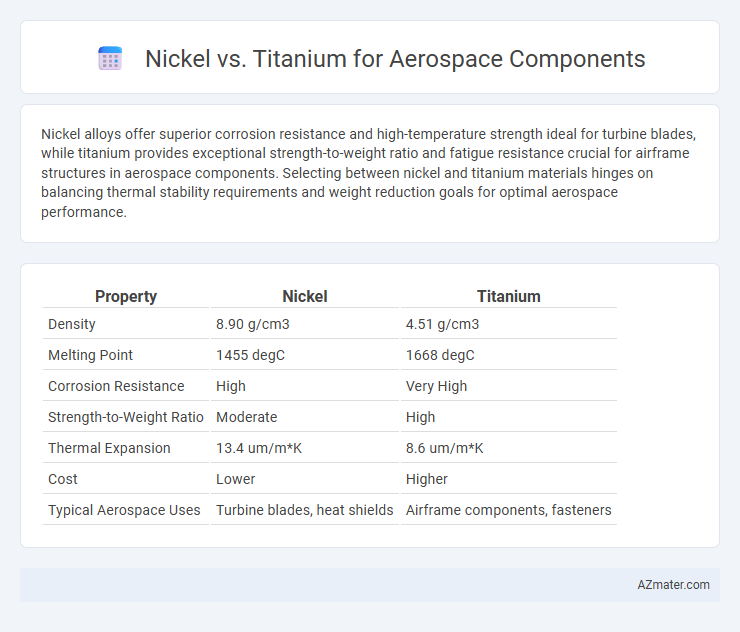Nickel alloys offer superior corrosion resistance and high-temperature strength ideal for turbine blades, while titanium provides exceptional strength-to-weight ratio and fatigue resistance crucial for airframe structures in aerospace components. Selecting between nickel and titanium materials hinges on balancing thermal stability requirements and weight reduction goals for optimal aerospace performance.
Table of Comparison
| Property | Nickel | Titanium |
|---|---|---|
| Density | 8.90 g/cm3 | 4.51 g/cm3 |
| Melting Point | 1455 degC | 1668 degC |
| Corrosion Resistance | High | Very High |
| Strength-to-Weight Ratio | Moderate | High |
| Thermal Expansion | 13.4 um/m*K | 8.6 um/m*K |
| Cost | Lower | Higher |
| Typical Aerospace Uses | Turbine blades, heat shields | Airframe components, fasteners |
Introduction to Nickel and Titanium in Aerospace
Nickel and titanium are critical materials in aerospace engineering due to their exceptional strength-to-weight ratios and corrosion resistance. Nickel alloys, such as Inconel, offer superior high-temperature strength, making them ideal for turbine blades and engine components. Titanium's low density and excellent fatigue resistance make it the preferred choice for airframe structures and fasteners, contributing to overall weight reduction and fuel efficiency in aircraft design.
Material Properties Comparison
Nickel alloys exhibit exceptional high-temperature strength and corrosion resistance, making them ideal for turbine blades and engine components in aerospace applications. Titanium offers a superior strength-to-weight ratio, excellent fatigue resistance, and outstanding corrosion resistance, which is critical for airframe structures and engine parts requiring weight reduction. While nickel excels in thermal stability and oxidation resistance above 700degC, titanium sustains structural integrity at moderately high temperatures (up to 600degC) with significantly lower density, optimizing fuel efficiency in aerospace components.
Weight and Strength Considerations
Nickel alloys offer exceptional strength and corrosion resistance but are significantly heavier than titanium, making them less ideal for weight-sensitive aerospace components. Titanium provides a superior strength-to-weight ratio, reducing overall aircraft weight while maintaining high mechanical performance in extreme environments. This weight advantage translates to improved fuel efficiency and payload capacity, critical factors in aerospace design.
Corrosion Resistance Performance
Nickel alloys exhibit exceptional corrosion resistance in high-temperature and oxidative aerospace environments, maintaining structural integrity against harsh chemical exposure and salt spray. Titanium offers superior corrosion resistance in reducing environments and demonstrates excellent resistance to stress corrosion cracking and pitting, making it ideal for components in corrosive atmospheric conditions. Both metals provide reliable performance, but nickel alloys outperform titanium in extreme oxidative corrosion, while titanium excels in resistance to crevice corrosion and fatigue in marine or humid aerospace settings.
Temperature Tolerance and Heat Resistance
Nickel alloys exhibit exceptional temperature tolerance, maintaining mechanical strength and corrosion resistance at temperatures exceeding 1,000degC, making them ideal for high-temperature aerospace components like turbine blades. Titanium offers excellent heat resistance up to around 600degC, along with a superior strength-to-weight ratio, which is critical for weight-sensitive structures such as airframes and engine parts. The choice between nickel and titanium depends on the specific thermal requirements, with nickel favored for extreme heat environments and titanium preferred for moderate heat with lightweight structural demands.
Manufacturability and Machinability
Nickel alloys exhibit superior machinability with enhanced toughness and wear resistance, making them ideal for complex aerospace components requiring precise fabrication. Titanium offers excellent strength-to-weight ratio and corrosion resistance but poses challenges in manufacturability due to its low thermal conductivity and tendency to gall during machining. Advanced machining techniques, such as cryogenic cooling and specialized tooling, optimize titanium's workability, while nickel alloys benefit from traditional machining processes with less tool wear.
Cost Analysis and Economic Factors
Nickel alloys, such as Inconel, offer superior high-temperature strength and corrosion resistance but come at a higher material and processing cost compared to titanium alloys. Titanium provides an excellent strength-to-weight ratio and corrosion resistance, leading to reduced fuel consumption and maintenance costs over an aircraft's lifecycle. Economic factors favor titanium for weight-sensitive aerospace components due to lower long-term operational expenses despite higher initial raw material prices.
Specific Aerospace Applications
Nickel alloys like Inconel are preferred for aerospace components exposed to extreme temperatures such as turbine blades and combustion chambers, due to their exceptional heat resistance and corrosion durability. Titanium excels in structural applications including airframe components and engine mounts, thanks to its high strength-to-weight ratio and superior fatigue resistance. Combining nickel and titanium properties often enhances performance in jet engines, space vehicles, and aircraft landing gear systems where weight savings and thermal stability are critical.
Environmental Impact and Sustainability
Nickel alloys used in aerospace components exhibit high strength and corrosion resistance but have a significant environmental impact due to energy-intensive mining and processing, contributing to carbon emissions and habitat disruption. Titanium offers superior strength-to-weight ratio and corrosion resistance with a lower lifecycle carbon footprint, as it enables lightweight designs that improve fuel efficiency and reduce emissions during aircraft operation. Sustainable aerospace manufacturing favors titanium for its recyclability and reduced environmental burden compared to nickel-based materials.
Conclusion: Choosing the Right Material
Titanium outperforms nickel in aerospace components due to its superior strength-to-weight ratio and exceptional corrosion resistance, which enhances fuel efficiency and durability. Nickel-based alloys excel in high-temperature environments, making them ideal for engine parts exposed to extreme heat. Selecting the right material depends on specific operational conditions, balancing titanium's lightweight benefits against nickel's thermal performance.

Infographic: Nickel vs Titanium for Aerospace Component
 azmater.com
azmater.com